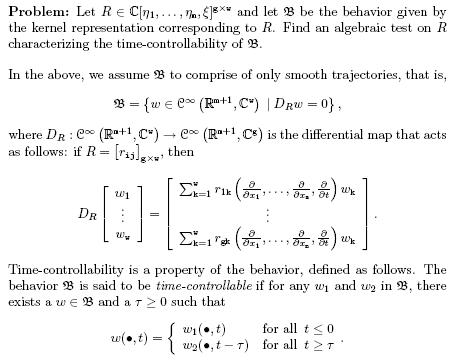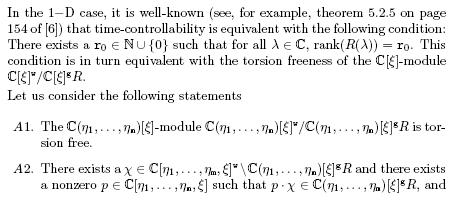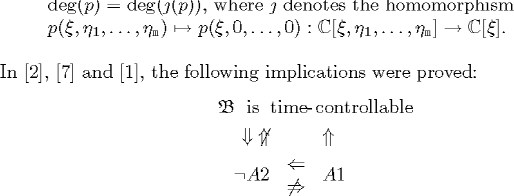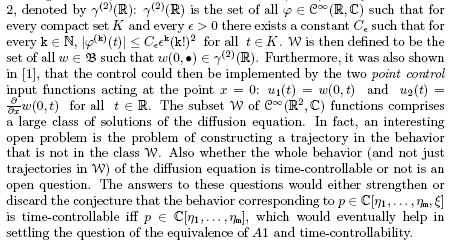Problem 1.8
The elusive iff test for time-controllability of behaviours
Amol Sasane
Faculty of Mathematical Sciences
University of Twente
7500 AE, Enschede
The Netherlands
1 DESCRIPTION OF THE PROBLEM

2 MOTIVATION AND HISTORY OF THE PROBLEM
The behavioral theory for systems described by a set of linear constant coefficient partial differential equations has been a challenging and fruitful area of research for quite some time (see, for instance, Pillai and Shankar [5], Oberst [3] and Wood et al. [4]). An excellent elementary introduction to the behavioral theory in the 1-D case (corresponding to systems described by a set of linear constant coefficient ordinary differential equations) can be found in Polderman and Willems [6].
In [5], [3] and [4], the behaviours arising from systems of partial differential equations are studied in a general setting
in which the time-axis does not play a distinguished role in the formulation of the definitions pertinent to control theory.
Since in the study of systems with “dynamics, ” it is useful to give special importance to time in defining system theoretic
concepts, recent attempts have been made in this direction (see, for example, Cotroneo and Sasane [2], Sasane et al. [7],
and ![]() amlibel and Sasane [1]). The formulation of definitions with special emphasis on the time-axis is straightforward, since they
can be seen quite easily as extensions of the pertinent definitions in the 1-D case. However, the algebraic characterization
of the properties of the behavior, such as time-controllability, turn out to be quite involved.
amlibel and Sasane [1]). The formulation of definitions with special emphasis on the time-axis is straightforward, since they
can be seen quite easily as extensions of the pertinent definitions in the 1-D case. However, the algebraic characterization
of the properties of the behavior, such as time-controllability, turn out to be quite involved.
Although the traditional treatment of distributed parameter systems (in which one views them as an ordinary differential equation with an infinite-dimensional Hilbert space as the state-space) is quite successful, the study of the present problem will have its advantages, since it would give a test that is algebraic in nature (and hence computationally easy) for a property of the sets of trajectories, namely time-controllability. Another motivation for considering this problem is that the problem of patching up of solutions of partial differential equations is also an interesting question from a purely mathematical point of view.
3 AVAILABLE RESULTS


Although it is tempting to conjecture that the condition A1 might be the iff test for time-controllability, the diffusion equation reveals the precariousness of hazarding such a guess. In [1] it was shown that the diffusion equation is time-controllable with respect to1 the space W defined below. Before defining the setW, we recall the definition of the (small) Gevrey class of order

BIBLIOGRAPHY
[1] M. K. ![]() amlibel and A. J. Sasane, “Approximate time-controllability versus time-controllability, ” submitted to the 15th MTNS, U.S.A., June 2002.
amlibel and A. J. Sasane, “Approximate time-controllability versus time-controllability, ” submitted to the 15th MTNS, U.S.A., June 2002.
[2] T. Cotroneo and A. J. Sasane, “Conditions for time-controllability of behaviours, ” International Journal of Control, 75, pp. 61-67 (2002).
[3] U. Oberst, “Multidimensional constant linear systems, ” Acta Appl.
Math., 20, pp. 1-175 (1990).
[4] D. H. Owens, E. Rogers and J. Wood, “Controllable and autonomous n-D linear systems, ” Multidimensional Systems and Signal Processing, 10, pp. 33-69 (1999).
[5] H. K. Pillai and S. Shankar, “A Behavioural Approach to the Control of Distributed Systems, ” SIAM Journal on Control and Optimization, 37, pp. 388-408 (1998).
[6] J. W. Polderman and J. C. Willems, Introduction to Mathematical Systems Theory, Springer-Verlag, 1998.
[7] A. J. Sasane, E. G. F. Thomas and J. C. Willems, “Time-autonomy versus time-controllability, ” accepted for publication in The Systems and Control Letters, 2001.
1That is, for any two trajectories in ![]() there exists a concatenating trajectory in
there exists a concatenating trajectory in ![]()
